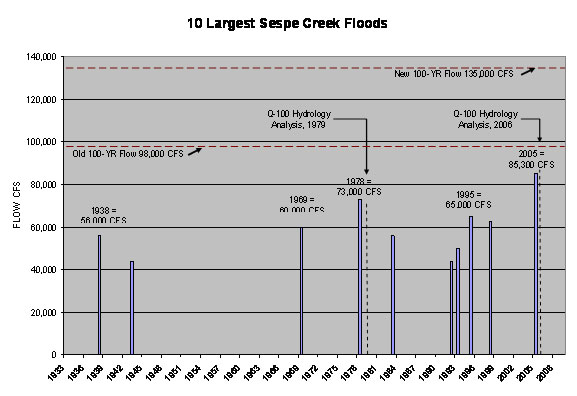|
Ask the Director
 This chart shows the 10 largest floods recorded on the Sespe Creek along with the old and new theoretical 100-year flows. By Bert Rapp — Wednesday, October 7th, 2009
 Bert Rapp City of Fillmore, Public Works Director Question: Why is the 100-year design flow in the Sespe Creek increasing I have never seen flood flows that high? Answer: The 100-year flood has a 1% chance of occurring in any given year. The design of the Sespe Creek levee was done in 1979 after the devastating Los Serenos flood in 1978. At that time we had about 46 years of records of flood flows on the Sespe Creek. The statistical flood analysis estimated a Q-100 of 98,000 Cubic Feet per Second (cfs) in 1979. Today we have 77 years of record. The Ventura County Watershed Protection District has applied the same statistical calculations used in 1979 to the enlarged data base and now calculates the Q-100 to be 135,000 cfs. A look at the flood flow record shows there has been a significant increase in high volume flood flows on the Sespe in the last 30 years. In the first 46 years of record from 1933 to 1979 there were four floods greater than 40,000 CFS. From 1979 to 2006 there were seven floods greater than 40,000 CFS in only 27 years! In 2005 the Sespe experienced the largest recorded flood of 85,300 CFS. This increase in large floods in the last 30 years is the driving factor in increasing the 100-year from 98,000 to 135,000. Given this flood flow record, the probability analysis calculates a theoretical Q-100 of 135,000 CFS. This means that there is a 1% chance in any given year that a flow of 135,000 CFS could occur. None of us has ever seen a 100-year flood flow on the Sespe Creek. The 1978 flow of 73,000 CFS is about equal to a 25 year flood and the record 2005 flow of 85,300 CFS is equal to about a 40-year frequency flood. If you have questions you may call Bert Rapp at 524-1500 x 231. |
